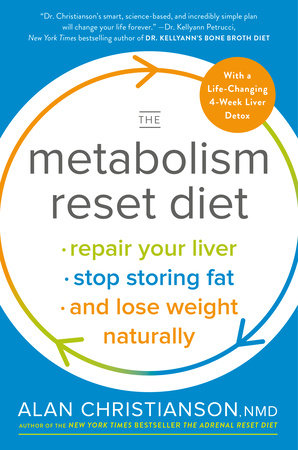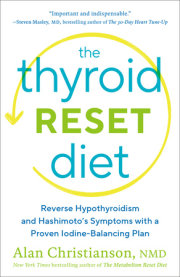Introduction
The Metabolism MysteryMaybe you’ve glanced at the plate of a coworker or friend and thought: Why can she indulge in that second piece of birthday cake—without tracking it or logging hours at the gym or feeling guilty for days—and stay naturally slim while I limit myself to a forkful and feel constantly fatigued and deprived and plagued with cravings . . . and overweight? Is there something wrong with me?
Here’s the essential truth that I hope will propel you into a new chapter of thinking about yourself and your health and your weight: There is nothing wrong with you.
Naturally thin people are not superior. They don’t try harder, nor do they possess superhuman willpower. They don’t have better genes, and most don’t eat fewer calories. They simply have one thing working in their favor: they have a better metabolism.
But for now, let’s take assessments of “good” or “bad” out of it. The word
metabolism is thrown around a lot in relation to diet and weight loss, but what does it actually mean? Your metabolism is simply how you convert fuel into energy. Fuel comes in as food. You never get exactly the right amount of food on a given day, but when you have a healthy metabolism, you can store a little extra food without gaining weight. That second piece of birthday cake isn’t going to make or break you. You can also miss a meal without your energy levels crashing.
When the metabolism is not working properly, we store too much fuel and we are unable to retrieve it. This leads to extra pounds and a host of other adverse effects—everything from brain fog to digestive problems to fatigue to diabetes to various forms of cancer.
There’s a common misconception that you are born with either a great metabolism or a bad one. But turns out that metabolism is not fixed. You can change. The key to this change is not in white knuckling it while the rest of your friends and family enjoy their lives, nor is it in forever eliminating your favorite foods. The secret that I discovered in my years of clinical practice and research is simply this: Clean out your liver so that it can burn fat better.
It's All About Your LiverThe liver probably isn’t even in the top five body parts you consider when you think weight loss, but it should be. The liver is more than just an organ damaged by alcohol or a quivering dish you’d prefer to avoid. It’s the heaviest internal organ and the largest gland in your body. It’s a powerful machine that acts as a filter to remove toxins, aids in digestion, and regulates hormones and blood sugar. It’s an incredible multitasker and a vital organ in the truest sense of the word—the hub through which your body’s energy flows. The liver is responsible for processing everything you ingest, and it also functions as your body’s storage pantry. Nutrients (vitamins, minerals, and other substances the liver needs to work at its best) and fuel (from our main calorie sources—fats and carbohydrates) you do not need today are stored in the pantry for later. The surplus is essential because you never get exactly what you need each day. If you miss a meal one day, you should be able to draw on your surplus to compensate. And if you overeat, you should be able to store the extra for use on those days when you may not have enough time to take a bite. A healthy liver stores extra energy and doles it out later when you need it.
What happens when your liver is unhealthy? You tend to store fuel as fat, especially around your midsection, and you can no longer tap into the nutrients you need to burn fat. This means that no matter which diet you choose—and how hard you try—weight loss is pretty much impossible.
Sound familiar?
Countless diets have told us to eat this “good food” and avoid that “bad food.” Meat, grains, butter, legumes, ketones, potatoes, tofu, canola oil—are they good or bad? Each passing day seems to bring a new wave of “science” that cancels out all previous assessments. In fact, fat, carbs, and ketones work collectively as fuel. A healthy liver can either store fuel or burn it. An unhealthy liver can only store it. All sources of fuel look the same to your liver—none are magic tonics or evil villains. This means that once you heal your liver, eating that piece of cake won’t be catastrophic. Your metabolism will be flexible enough to adapt and handle whatever curveballs you throw its way.
That’s very good news. And even better news? Healing your liver takes weeks—not months or years. The liver is an astonishingly resilient organ. With the steps I’m going to give you in this book, you can restore it to perfect working order in just a few weeks.
Why This Matters to Me When people meet me, many assume that I am naturally thin. I take it as a compliment, but in fact when I was young I struggled with my weight. I was born with cerebral palsy and epilepsy. Perhaps being unable to be physically active put me at risk for weight gain. The first time I was obese was when I was eleven years old. Overweight kids were over three times rarer in the 1970s than they are today, so I stood out. Fat discrimination and fat-shaming are still injustices these days, but back then they were not even concepts; they were just the normal state of affairs. What is now often still held as a private belief was then publicly shared—it was assumed that anyone who was overweight just needed to try harder.
In fact, I was anything but lazy and I tried hard at everything I put my mind to. I hated how I looked and I wanted to change. Willpower was not the problem. Besides my weight, it seemed that I could push through any obstacle. I knew that I had no less persistence than my thin peers did.
I went to the doctor, but his solution of logging calories didn’t work. It wasn’t until I turned to health books that I was able to make a difference. I read everything I could get my hands on, and based on the advice I gleaned, I cut out sugar, butter, and bread completely. I didn’t touch any of those three foods for about a decade. My parents indulged a family member who sold multilevel supplements. Thankfully, this meant that we had protein powder available, and I started every day with a protein shake. For lunch and dinner my mom made good meals with whole foods. I added beginner exercise routines designed for sedentary people, and slowly but surely, I saw things change.
Once I got healthier, my life transformed. I felt better about myself, more confident and capable. For the first time, I came to experience the joy of movement. My physical abilities improved almost on a daily basis and I loved it.
In my mind, I owed my new lease on life to the health experts who shared their advice in books. They were my heroes, and I wanted to follow in their footsteps, so I decided to pursue medicine as my life’s work. My transformation even guided my focus within medical school. I became fascinated by hormones because of their seemingly enigmatic role in regulating body weight. I knew how emotionally powerful my own struggle had been and how much effort it took. My heart went out for those in the same place who worked just as hard, yet saw no results. I dedicated my career to helping them.
While working with diabetics, I was exposed to the idea of modified fasting as a means to improve health. I read studies from 2011 in which advanced diabetics became cured by following a 600 calorie, liquid-only diet for eight weeks. The process sounded extreme, but so were the results. Blood tests and CT scans showed that these patients’ pancreases had completely healed and were able to produce insulin normally. They no longer needed medication at all. It turned out that once their livers cleared out the old deposits of fat, they became nondiabetic.
This was a huge finding, and a surprising one as well. Historically we’d thought of the pancreas as the master organ related to diabetes—and once you were on a diabetic track, it was as if you were strapped to a runaway train. But this new research showed that the pancreas is only part of the picture. The liver also plays a crucial role because it has a remarkable ability to heal.
After reading all the related studies I could find, I asked several patients if they would be willing to try something new. My idea was that many who were pre-diabetic, or had less advanced diabetes, would be able to heal with a less intensive regime.
Instead of three liquid shakes, I tried two shakes and one reasonable meal. The results were tremendous. I tracked people every two weeks and saw that most achieved remission from diabetes well before eight weeks. The goal of the early program was diabetes reversal, and our clinic has logged countless cases of those who did just that. They became non-diabetic, stopped their medication, and continue to remain healthy years later.
Nearly everyone we treated had fatty liver syndrome, even though few ever had heard the term before. When the liver is overburdened by excess sugar, the body stores it as fat. This can trigger a potentially devastating inflammatory response, which has been linked to heart disease and some forms of cancer. What’s more, new research suggests that fatty liver is not just
the consequence of weight gain, it can also be
the cause of weight gain. So addressing fatty liver syndrome is crucial in the fight to both regain health and lose inches. And the protocol I was sharing with my patients was working miracles.
Copyright © 2019 by Alan Christianson, NMD. All rights reserved. No part of this excerpt may be reproduced or reprinted without permission in writing from the publisher.









